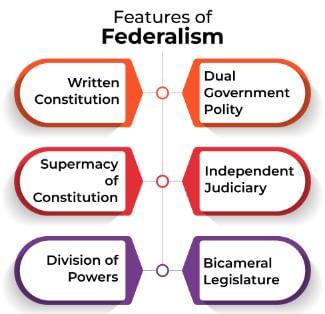Test: Weekly Current Affairs: June 8th to 14th - UPSC MCQ
25 Questions MCQ Test - Test: Weekly Current Affairs: June 8th to 14th
Consider the following statements:
- The Andhra Pradesh Reorganisation Act, 2014, led to the creation of Telangana.
- The demand for a separate Andhra state for Telugu-speaking individuals arose primarily to promote administrative efficiency.
- Potti Sreeramulu's death led to the formation of India's first linguistic state, Andhra.
How many of the statements given above are correct?
Consider the following statements:
- The NOTA option was introduced following a Supreme Court directive in 2013.
- NOTA votes are counted as valid votes and can alter election outcomes.
- The People's Union for Civil Liberties (PUCL) advocated for voter secrecy.
How many of the statements given above are correct?
Consider the following statements:
- The Special Category Status (SCS) was introduced in 1969.
- The 14th Finance Commission recommended reserving SCS for Northeastern and three hill states.
- Andhra Pradesh currently holds Special Category Status.
How many of the statements given above are correct?
Consider the following statements:
- The Regional Rapid Transit System (RRTS) aims to reduce air pollution and encourage public transport use.
- The RRTS project includes the Delhi-Meerut, Delhi-Panipat, and Delhi-Alwar corridors.
- The Gravity Model is associated with the idea that settlements develop around central locations.
How many of the statements given above are correct?
Consider the following statements:
- The Household Consumption Expenditure Survey (HCES) is conducted every 5 years by the National Statistical Office (NSO).
- Milk and Milk Products expenditure is highest in southern states like Kerala and Tamil Nadu.
- Non-food expenditure has shown an increasing trend over the years.
How many of the statements given above are correct?
Consider the following statements:
Statement-I: The demand for Special Category Status (SCS) for Andhra Pradesh is based on its geographical and socio-economic disadvantages.
Statement-II: The 14th Finance Commission excluded most states from SCS, focusing only on Northeastern and three hill states.
Which one of the following is correct in respect of the above statements?
Consider the following statements:
Statement-I: The formation of Andhra State in 1953 marked India's first linguistic state.
Statement-II: The JVP Committee recommended reorganizing states based on language lines to promote cultural preservation.
Which one of the following is correct in respect of the above statements?
Consider the following statements:
Statement-I: The RRTS project is a rail-based semi-high-speed transit system for the NCR region.
Statement-II: The Central Place Theory explains the development of urban settlements around key central locations.
Which one of the following is correct in respect of the above statements?
Consider the following statements:
Statement-I: NOTA votes in Indian elections are counted as 'invalid votes' and do not alter the election outcomes.
Statement-II: The Supreme Court mandated the introduction of NOTA in 2013 to empower voters.
Which one of the following is correct in respect of the above statements?
Consider the following statements:
Statement-I: The Household Consumption Expenditure Survey provides data for calculating Monthly Per Capita Consumer Expenditure (MPCE).
Statement-II: The HCES covers the entire Indian Union, excluding a few inaccessible villages.
Which one of the following is correct in respect of the above statements?
Consider the following pairs:
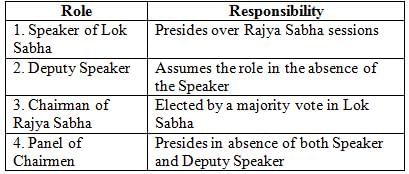
How many of the above pairs are correctly matched?
Consider the following pairs:

How many of the above pairs are correctly matched?
Consider the following pairs:
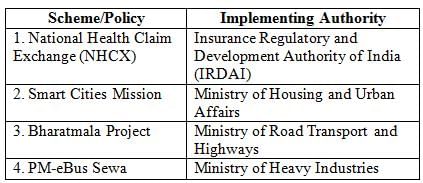
How many of the above pairs are correctly matched?
Consider the following pairs:
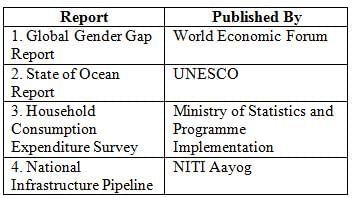
How many of the above pairs are correctly matched?
Consider the following pairs:
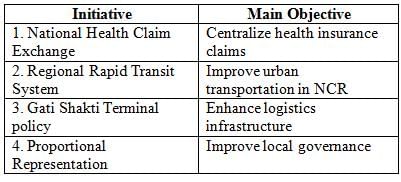
How many of the above pairs are correctly matched?
Consider the following statements:
Assertion (A): The Speaker of Lok Sabha has the power to adjourn meetings in the absence of quorum.
Reason (R): The Speaker ensures order and decorum during the proceedings of the House.
Which one of the following is correct in respect of the above statements?
Consider the following statements:
Assertion (A): The Special Category Status (SCS) was introduced to assist states with geographical and socio-economic disadvantages.\
Reason (R): The SCS provides states with higher financial assistance from the central government.
Which one of the following is correct in respect of the above statements?
Consider the following statements:
Assertion (A): The National Health Claim Exchange (NHCX) aims to simplify cashless claims in India.
Reason (R): The NHCX was launched by the National Health Authority (NHA) and the Insurance Regulatory and Development Authority of India (IRDAI).
Which one of the following is correct in respect of the above statements?
Consider the following statements:
Assertion (A): Bihar is seeking Special Category Status to address its significant socio-economic challenges.
Reason (R): Granting Special Category Status automatically leads to higher industrial development.
Which one of the following is correct in respect of the above statements?
Consider the following statements:
Assertion (A): The Global Gender Gap Report 2024 highlights that the largest gender disparities persist in Political Empowerment and Economic Participation & Opportunity.
Reason (R): These disparities are due to the increased caregiving responsibilities on women and lower representation in leadership roles.
Which one of the following is correct in respect of the above statements?
Which one of the following in Indian polity is an essential feature that indicates that it is federal in character?
Consider the following statements regarding the velocity of money:
- The velocity of money increases when the frequency of transactions in an economy rises.
- A high velocity of money typically indicates a high level of economic activity.
- If the velocity of money decreases, it suggests that people are holding onto their money rather than spending it.
How many of the above statements is/are correct?
Which organization is responsible for conducting the ‘Household Consumption Expenditure Survey 2022-23’ in India?
Which body is established at the central level to oversee the implementation of the RTI Act?
Consider the following statements about the Global Plastics Treaty:
- The treaty aims to reduce plastic pollution by setting legally binding targets for all member countries.
- The treaty was adopted by the United Nations Framework Convention on Climate Change in 2024.
- The treaty focuses solely on reducing single-use plastics.
How many of the above statements is/are correct?



